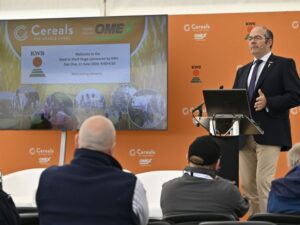 Weeds and diseases are two of the biggest threats to profitable arable farming, and with chemical resistance dominating product choice, it’s more important than ever for farmers to make use of the most efficient control methods.
Weeds and diseases are two of the biggest threats to profitable arable farming, and with chemical resistance dominating product choice, it’s more important than ever for farmers to make use of the most efficient control methods.
From the latest chemistry to novel cultural techniques and expert scientific advice, there will be something to address everyone’s challenges at this year’s Cereals Event (13-14 June).
Blackgrass remains one of the most detrimental weeds right now, and as the future of glyphosate hangs in the balance, many have turned to cultural control measures – like delayed drilling – to tackle it. However, late drilling comes with its own issues, explains Mark Tucker, business and agronomy development manager at Yara.
“Firstly, the soil state as a medium is poorer – with the temperature dropping by about two degrees and becoming wetter – which reduces growth rates and nutrient availability. Secondly, four weeks of the growth period has been lost. This is crucial as the fundamental for high yields is crop biomass.”
To remedy this, Yara is looking at the role crop nutrition can play in recovering some of the lost yield potential. “Using a combination of fertiliser and foliar applied nutrients can help to increase early spring growth rates,” explains Mr Tucker. “Nutrient levels will be at their lowest in the spring so it’s important to apply a fertiliser to meet the crop requirements and use a phosphate source that is not immediately locked up, to give long, continuous supply to the crop.”
Mr Tucker recommends using foliar phosphate to give the growing crop a boost of energy and accelerate early spring growth. “It’s also worth applying a higher nitrogen rate at this time,” he adds. “This will give faster leaf and tiller development to recover the lost biomass.”
Management of other weeds and diseases is similarly complex, and with so many chemical controls on the market, it’s easy to lose track of the best products available.
One of the cutting-edge products being featured at this year’s Cereals Event is Dow DuPont’s new oilseed rape herbicide – based on Arylex Active. This promises broad-leaf weed control and its reliability in variable temperatures and flexible timing of application will allow growers to deal with key problem weeds when they appear, rather than front-loading programmes with what can be expensive, high-risk pre-emergence strategies.
“This gives growers peace of mind because they will see a crop coming out of the ground and established before spending any money on weed treatments,” says John Sellars, oilseed rape herbicide product manager at Dow AgroSciences. “They can assess the level of broad-leaved weeds in their crop and make a decision based on fact, not guess work.”
Disease pressures vary depending on a number of factors including location, soil and weather, and managing this can be a fine balancing act. Fortunately, Syngenta will be on hand at Cereals 2018 to advise growers how best to manage cereal diseases in different scenarios. “We have done a lot of trial work this year looking at the role variety choice can play in minimising disease pressures,” explains Iain Hamilton, field technical manager at Syngenta. “We’ve looked at varieties that have certain disease profiles and how they can be used to tackle disease – taking in to account seasonal factors, drilling dates and where best to use products.”
Though traditionally variety choice was influenced by yield potential, farmers are now looking more at disease profiles, he adds. “Farmers need to be proactive from the start. It’s all about risk management – you cannot just rely on fungicides.”
There’s no question that agriculture is in the midst of a technological revolution, and growers are increasingly turning to digital platforms to assist with their control strategies.
According to Jack Harris, precision technology specialist at Agrovista, developments in drone technology are driving a rapid rise in aerial agronomy. “Drones can now measure a range of crop parameters such as establishment biomass and presence of weeds and diseases, as well as plant counts – gathering data from large areas in minutes.
“Flying a field with a near-infra-red camera highlights variations in the crop canopy,” he adds. “We can then overlay other information based on farmer input – such as yield maps, soil tests and scans – to build a variable rate nutrient map.” Visitors to the Cereals Event will be able to view a range of agronomic software, as well the latest drones in action with live flights in the Drone Zone.
While crop protection often relies heavily on chemical controls, more traditional approaches – such as cultivations – can be just as effective. With flea beetle, blackgrass and slugs making oilseed rape establishment challenging, He-Va’s new Evolution rape drill could be the answer. This fully-loaded machine can achieve precision drilling and seed placement, soil and nutrient management and pest control in one pass.
The seed bed is prepared by low disturbance, medium-depth sub-soiling legs which alleviate compaction and improve soil structure, to encourage good rooting. A V-profile roller then re-consolidates, creating a micro-tilth ready for seed placement. Slug pellets can be accurately applied in the same pass, using He-Va’s twin multi-seeder.
“Establishing oilseed rape has been difficult again this year with flea beetle hammering crops at cotyledon stage,” says James Woolway, Opico’s managing director. “This, combined with blackgrass and slug pressures, is making it very challenging to get a profitable crop out the ground. The new Evolution seeder throws all our best technology at the plant, getting it off to a good, strong start and able to withstand any pest pressures.”
For more information about this year’s Cereals Event visit: http://www.cerealsevent.co.uk/



